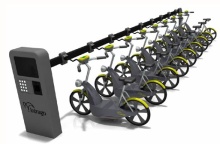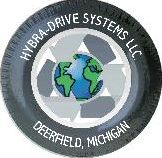 Every year, the Cleantech Forum sweeps into San Francisco, an industry event including banks, corporations, startups and venture capitalists.
Every year, the Cleantech Forum sweeps into San Francisco, an industry event including banks, corporations, startups and venture capitalists.
I got to check out some of the startups presenting at the event, and found it to be an interesting mix. Sometimes it feels like cleantech is just a monotone of the same ideas: The next new solar cell, wind turbine or electrical system that can (maybe) be cheaper and more efficient than the last generation. The ten companies below, however, run the gamut of creative tech, from air recycling and filtration, to electric bike rentals, to metal-based origami.
Here are the start-ups I saw, beginning with the most interesting and working down:
 PVT Solar
PVT Solar
Most people know that standard solar photovoltaic cells generally have a maximum efficiency of around 15 to 20 percent, but they don’t know what happens to the 80 percent of the energy the cells can’t capture. Simple answer: It turns into waste heat. PVT Solar simply lifts up the cells a bit over their base, creating a pocket of air that’s heated with the energy the cells lose. The air is then circulated through a heat engine to harvest the energy, or alternatively, piped into a household’s air or water heating system. Installing the system raises the cost for the solar units about 20 percent, but boosts the energy generated by 100 percent in any climate, according to the company, helping to reduce the time to break-even on the investment by 25 to 50 percent. Those numbers are pretty impressive, and make for an excellent counter-argument to the Berkeley professor who recently called solar PV an economic “loser”. PVT is just closing its first round of investment, but will open another round fairly soon.
Projected revenue, 2008: $2 million
Looking for: $4 million
Previously taken: $1 million (plus around $3 million for its first full round, when closed)
 Intrago
Intrago
This one occasioned a dinner-time argument at my table. The question: Is there any chance of creating a short-distance commuter bike rental market within American cities, ala London and Paris? Intrago, to be sure, has some innovative ideas; aside from bikes, they rent out scooters and cars, and all of them are electric. (Although that also feels a bit like a jibe at the stereotype of the Fat American, unwilling to even pedal.) Personal keys and PIN numbers help keep track of who’s renting what, and included GPS units help balance the system out, so that the vehicles don’t all pile up in one location. But at the same time, I feel like it’s too early for mass bike-rental systems in American cities, and Zipcar has already provided a healthy injection of innovation to the car rental market. More promising is the campus market, which Intrago is wisely starting its business off in. The University of Washington and a corporate campus in the Bay Area have already signed up.
Projected revenue, 2008: $1.7 million
Looking for: $4.5 million
Previously taken: $1 million
Sorbent Technologies
This startup, which aims to suck the mercury out of the toxic gas emissions of coal-burning plants, received a boost a few days ago when courts ruled that the Environmental Protection Agency must impose stricter mercury rules on coal plants. Sorbent Technologies installs new boilers for those plants, but also makes its own sorbent (also the name of the substance that captures mercury from the air), which is its real business plan — as long as coal is burned, the plants will need to buy more sorbent. Unlike competing companies, Sorbent Technologies can preserve fly ash for making concrete, and says that its proprietary sorbent mix is more effective than others.
Projected revenue, 2008: $10 million
Looking for: $1.5 – 2 million working capital, plus another $4 – 6 million in a round immediately afterward
Previously taken: $2 million
 MicroPlanet
MicroPlanet
MicroPlanet is a great example of a simple but effective technology aimed at increasing electrical efficiency. The voltage of electricity delivered to a house or business from a utility can vary considerably from the optimum level used by appliances. MicroPlanet sells a product that varies depending on the size of the application and the location, but it always does the same thing: Changes all incoming electricity to the perfect voltage, thus reducing the amount of energy that escapes as waste heat. The company has tested its systems extensively, and found a 6 to 12 percent efficiency gain. It prices its units to pay for themselves within about three years.
Projected revenue, 2008: $5 million
Looking for: $12 million
Previously taken: $20 million
 Hybra-Drive Systems
Hybra-Drive Systems
You’ve heard of electric hybrids, but have you head of a hydraulic hybrid? It’s a similar idea, but instead of storing energy in a battery, it’s tucked away into hydraulic cylinders. (And if that blows your mind, check out the air car.) Various companies including Ford are toying with hydraulic hybrids, but Hybra-Drive doesn’t have its eye on the consumer market. Instead, it wants to work with commercial applications like construction vehicles and trucks, and just won half a million in funding from the Army for its work in boosting a Humvee from 8 to 23 miles per gallon.
Projected revenue, 2010: $89 million
Looking for: $10 million
Previously taken: $1.6 million
 Industrial Origami
Industrial Origami
Origami is the art of paper folding. That’s a pretty accurate description of Industrial Origami’s business model, with one exception: They use aluminum and steel. The company can, by cutting a single contiguous shape from a flat sheet of metal, cleverly fold the resulting form into various objects, including cars and washing machines. The process saves anywhere from 20 to 70 percent of the manufacturing cost, reducing the amount of raw material needed, and cutting out the need to ship bulky consumer appliances in from far away places (instead, just ship in the shaped metal and fold it at a home factory). The idea is hardly unique, but the company has good execution, and it’s got 350 patents either approved or in the works to defend its methods.
Projected revenue, 2008: $3 million
Looking for: $10 million
Previously taken: $15 million
 Pentadyne
Pentadyne
While other startups are considering various methods aimed at storing enough power to last for hours at a time for utility-scale solar and wind developments, including molten salt, compressed air and weighted arrangements, Pentadyne only wants to provide a power source more reliable and effective than batteries for a few seconds at a time. The company makes flywheels for sale to data centers, which need to have an interim supply that is capable of coming online immediately in case of a power outage, but just long enough for diesel generators to kick in. The company also makes “energy recycling” systems for mass transit — think regenerative braking for trains. Unlike some of the other companies presenting, Pentadyne already has substantial sales, and even more substantial funding.
Projected revenue, 2008: $18 million
Looking for: $15 – 25 million
Previously taken: $56 million
 Nanoexa
Nanoexa
Like a number of other startups, Nanoexa is working on making the lithium-ion battery more efficient. It has a high-speed computational modeling tool that helps discover better and cheaper materials for use in the batteries and their parts, and also says it can exceed the performance of competing technologies by 20 percent. Problem is, like most battery startups, it requires a hell of a lot of capital to get off the ground, not to mention that it’s competing for the hand-tool and automotive markets with companies like A123, which have already raised heaps of funding. Only time will tell whether Nanoexa’s batteries are good enough to compete not only with existing next-gen technologies like A123, but also with ultra-capacitors, fuel cells, and a host of other upcoming battery innovations.
Projected revenue, 2008: $728,000
Looking for: $25 – 50 million
Previously taken: $2 million
 SOMS Technologies
SOMS Technologies
SOMS makes a high efficiency engine oil filter that it claims can last for 30,000 miles of driving, about ten times the recommended range for standard filters. The cost-saving from the filter is two-fold, because vehicles also end up burning less oil when using a better filter. The company plans to start off selling to the commercial fleet market, and expects an acquisition in the future.
Projected revenue, 2008: $1 million
Looking for: $3 million
Previously taken: $900,000
Verilite (contact)
Verilite is a solar concentrator technology that uses flat mirrors to direct sunlight into a concentrator prism, which redirects the light to a bank of photovoltaic cells. “It’s so simple, we can’t fail!” said the company’s president as he wrapped up his presentation. While endearing, bubbly enthusiasm isn’t much of a substitute for hard details, so it’s difficult to tell just how successful this company could become.
Projected revenue, 2008: $0.5 – $1 million
Looking for: $3.5 million
Previously taken: $0.5 million

